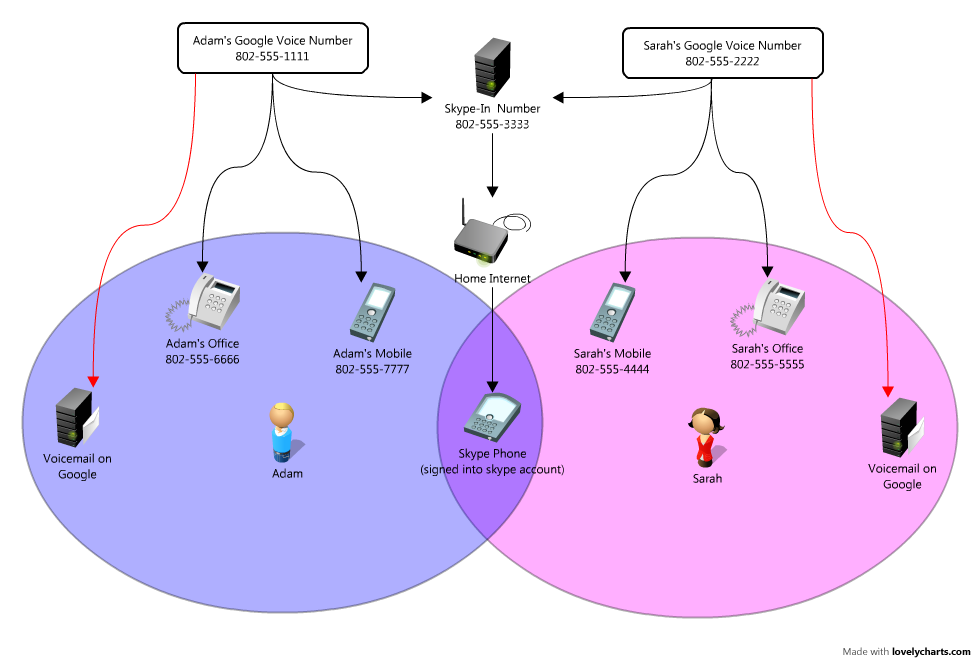As members of the under-30 club, Sarah and I have come into adulthood in the age of mobile phones. I got my first cell phone right after college and Sarah has had hers since she was 14; neither of us has ever had a land-line of our own.
While the mobile-only lifestyle has generally worked great for us over the years, it does have downsides that have become more apparent as our lifestyles have shifted to a more settled routine. Currently Sarah and I find ourselves generally splitting our time between work and home. At work we each have an office phone supplied, but we had only had our mobile phones at home. An unfortunately common occurrence was for one of us to come home and leave the mobile on silent/vibrate in a coat pocket and become unreachable. After a few incidents of being stranded, stood up, or not getting the message to pick up milk we decided that a home phone was needed — but were shocked to find that a local-only land-line would run us $40 per month (about the same as a cell phone plan in this area).
We were in search of a solution that would allow us to have a phone ringing audibly at home, keep our mobile phones for mobile usage, and come in at less than $120/month (if not lower our bills). Our solution is shown in the diagram below. While it looks a bit complicated, it meets our goals, didn’t require any tricky setup, and comes in at a grand total of $50/month for maintaining two mobile phones and a home phone. It has the added benefits of a single number to reach each of us and Google’s snazzy transcribed-voice-mail service.
The new home phone: Skype + a handset
The first piece of the puzzle was to purchase a handset (the IPEVO SO-20) that sits at home on our wireless network, signed in to my Skype account. This handset works just like the Skype-application on a desktop computer, but doesn’t require keeping a large computer on to make or receive Skype calls. In addition to making free Skype-to-Skype calls, Skype also offers services for making calls from your Skype client to normal telephone numbers (known as “Skype-Out“) as well as a service which provides you with a telephone number that will ring your Skype client (known as “Skype In“). Skype-Out charges a minimal 2-cents/minute for calls to most of the world and maintaining the Skype-In number costs $3/month with no charge for talk-time.
We’ve been using the Skype phone for a few months now and have been very pleased with it. We notice a 1-1.5 second delay in hearing the caller when we first answer a call. This was a little confusing at first and resulted in a lot of “Hello? Hello? Can you hear me?” back-and-forth with the caller, but the delay is only at connection time and saying “Hello?” and then just pausing for a moment gives the call time to connect fully. Once in a call, the audio quality is generally a bit better than my mobile phone.
Routing calls with Google Voice
With the Skype-phone in place we now had a number that would reliably ring at home and costs us less than $10/month for a few hours of incoming and outgoing calls to anywhere in the world. Now the question is: How do we get people to call us on the Skype-phone rather than our mobile phones? Enter (from stage left) Google Voice.
Google Voice (from here out referred to as “GV”) is at its heart a phone-number forwarding service. The basic idea is that you get a GV phone number and then in your account settings, configure it to forward incoming calls to one or more other phone numbers. When a call comes in, all of your phones ring at the same time (this can be quite shocking if you have them in close proximity) and you pick up whichever one is at hand (and doesn’t incur a usage fee if you want to avoid that). Once you’ve picked up one phone the others stop ringing and you talk away.
I have my GV set up to ring three phones, my mobile number, our Skype-In number, and my work number. Since I spend the majority of my time either at work or home, most of the time I pick up calls at one of those two places. This cuts my mobile phone usage to only a few days per week, opening up other options for cutting costs.
Prepaid mobile + minimal usage = savings
Another driver for this entire phone-system change was that Unicel’s network in Vermont was recently sold to AT&T. After some bad customer-service experiences with Verizon I switched to Unicel in 2007 and was very happy with their service. In particular, they used unlocked GSM phones and didn’t charge for incoming calls or text messages, all for $35/month. With the sale to AT&T I was looking at an increase to $40/month for the minimal plan plus airtime usage for incoming calls.
With the Skype-phone in place and GV forwarding calls to all numbers, our mobile-phone usage wasn’t as high, allowing us to try some other options. Rather than signing up for a new AT&T contract, I instead kept the unlocked phone I used with Unicel and went with a prepaid (“GoPhone“) plan from AT&T. Rather than paying a monthly fee, I pre-pay on my account and then only have my account balance debited when I use the phone. I’m currently using the version of the plan where I pay $1/day on days that I use the phone, plus 10-cents/minute. While this sounds like it would add up, with GV routing calls to my other numbers I’ve averaged $16/month in mobile charges for the past two months. Also, unlike the monthly phone contract this has the potential to get much lower as more friends and family learn of my GV number and stop calling my mobile directly.
All said and done
From a pure cost perspective this telephony setup has been a big success. From two cell phones at $40/month each for a total of $80/month (with additional for a home phone); we’ve now gone to $3/month for the Skype-In number with ~$3/month of Skype-out calls from home, plus about $16/month each in mobile phone charges leaves us with a new total of a bit under $40/month. We had the additional $140 up-front cost for the IPEVO Skype-phone, but amortized over a year that still leaves us at about $50/month, with the potential to drop costs further if our cell-phone usage drops.
The non-monetary benefits are certainly harder to quantify. The biggest benefit I find is the increased control over my phone environment. For example, I could swap out the Skype-phone for something else (or get rid of it entirely) and no callers would know the difference. Once my contacts are all using my GV number, the same is true of my mobile phone.
Other features of GV such as voicemail transcription, caller filtering, scheduling of times when each phone should ring, and free SMS sending are all pretty neat too, but I haven’t yet made heavy use of them.
Now for the downsides:
- Complexity: While I find the increased flexibility valuable and none of the steps are challenging, others may find the whole thing not worth the hassle to set up.
- A new number: While I now have one number that will ring all of my phones, Google currently doesn’t support transferring existing numbers to their service. I’m now trying to wean friends and family off of the mobile number I’ve had for 7 years.
- Apparently some have found that using GV causes delays or other audio degradation. I haven’t noticed this myself.
- One more thing relying on Google. Since all of the phone companies hosted NSA warrentless-wire-tapping computers in their data-centers, I’m not particularly worried about Google having my calling data as well. That said, I’m relying on them to stick around for my email, searching, RSS reading, spreadsheets, and now call-routing.
- Users don’t see my GV number in the caller id. You can make calls with GV so that the person you are calling sees your GV number in the caller-id, but this requires either initiating the call from the GV website (your phone rings first), or dialing your GV number, then from there initiating the call. I find this to be too much hassle so I never bother
One final note: If you are a friend, family, or colleague who I missed in my number-update-email, let me know and I’ll send you my new GV number. 🙂







Very cool set-up. Too bad google voice is currently only available in the US…
Very cool. My wife and I tried to something similar. But the problem with the above setup is, we each still wanted a data plan.